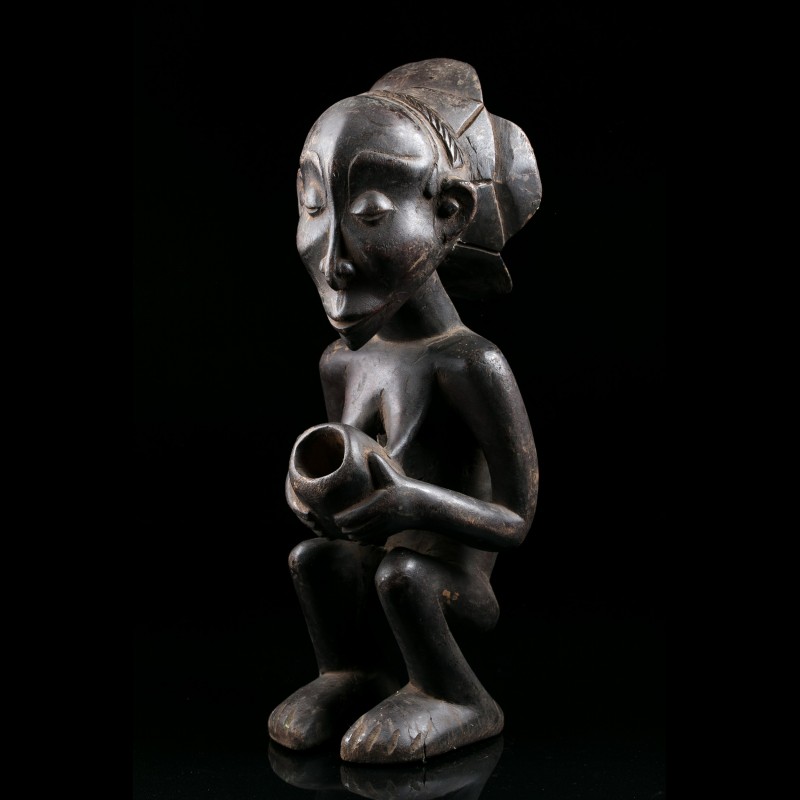












In African art, currently, there are more than twenty works of "masters of Buli", the name of the village where Father Maurice discovered a throne of this style. This coin comes from the Kanunu region, then included in the Luba kingdom. At the heart of this kingdom, when the kaolin of the king runs out, the two guardian spirits of the royalty make appear a calabash of kaolin mboko on the surface of their sacred lake if they judge the sovereign worthy to reign; the calabash joins itself to the enclosure of the palace where the king insures the worship of his ancestors; his dignitaries then offered him a female statue, probably a cup-bearer, to deposit the container.
The sculpture represents Mpanga, the feminine spirit, while the calabash is the sign of Banze, her husband or his twin according to the versions. The main users of these statues, however, are not the political leaders but the kilumbu mediums, which make the divination in a state of trance inspired by the spirits. Their major charm is the Mboko calabash in which their spirits reside. To make the divination, some psychics shake their calabash and establish a diagnosis by observing the configuration taken by the charms that are inside. The cup bearer represents the diviner carrying the Mboko of his spirits.
The female identity of these statues is that the union between man and woman serves as a metaphor for the alliance between spirits and humans, the first finding on earth their "wives" in the form of living rituals or of statues. Cutting carriers can heal by contact, protect a village against misfortune, etc. It is also used for a divination purpose, the diviner making the statue speak ventriloquistically. They fall into the general category of Nkishi, anthropomorphic statues used by mediums to magically influence the course of events. Like all Nkishi, cutters gain their effectiveness during a ritual where they are activated by inserting certain charms inside the container or into a horn stuck in the head, so that a spirit attaches to the statue and gives it its power.
You can buy other Baluba statues in our art gallery, the reference in Belgium in African art.
Provenance : collection privée P. Vandenbergh Datation estimée : années 1960 Taille : 36 x 13 cm Matériau : bois
Data sheet
You might also like

In African art, currently, there are more than twenty works of "masters of Buli", the name of the village where Father Maurice discovered a throne of this style. This coin comes from the Kanunu region, then included in the Luba kingdom. At the heart of this kingdom, when the kaolin of the king runs out, the two guardian spirits of the royalty make appear a calabash of kaolin mboko on the surface of their sacred lake if they judge the sovereign worthy to reign; the calabash joins itself to the enclosure of the palace where the king insures the worship of his ancestors; his dignitaries then offered him a female statue, probably a cup-bearer, to deposit the container.
The sculpture represents Mpanga, the feminine spirit, while the calabash is the sign of Banze, her husband or his twin according to the versions. The main users of these statues, however, are not the political leaders but the kilumbu mediums, which make the divination in a state of trance inspired by the spirits. Their major charm is the Mboko calabash in which their spirits reside. To make the divination, some psychics shake their calabash and establish a diagnosis by observing the configuration taken by the charms that are inside. The cup bearer represents the diviner carrying the Mboko of his spirits.
The female identity of these statues is that the union between man and woman serves as a metaphor for the alliance between spirits and humans, the first finding on earth their "wives" in the form of living rituals or of statues. Cutting carriers can heal by contact, protect a village against misfortune, etc. It is also used for a divination purpose, the diviner making the statue speak ventriloquistically. They fall into the general category of Nkishi, anthropomorphic statues used by mediums to magically influence the course of events. Like all Nkishi, cutters gain their effectiveness during a ritual where they are activated by inserting certain charms inside the container or into a horn stuck in the head, so that a spirit attaches to the statue and gives it its power.
You can buy other Baluba statues in our art gallery, the reference in Belgium in African art.
Provenance : collection privée P. Vandenbergh Datation estimée : années 1960 Taille : 36 x 13 cm Matériau : bois
